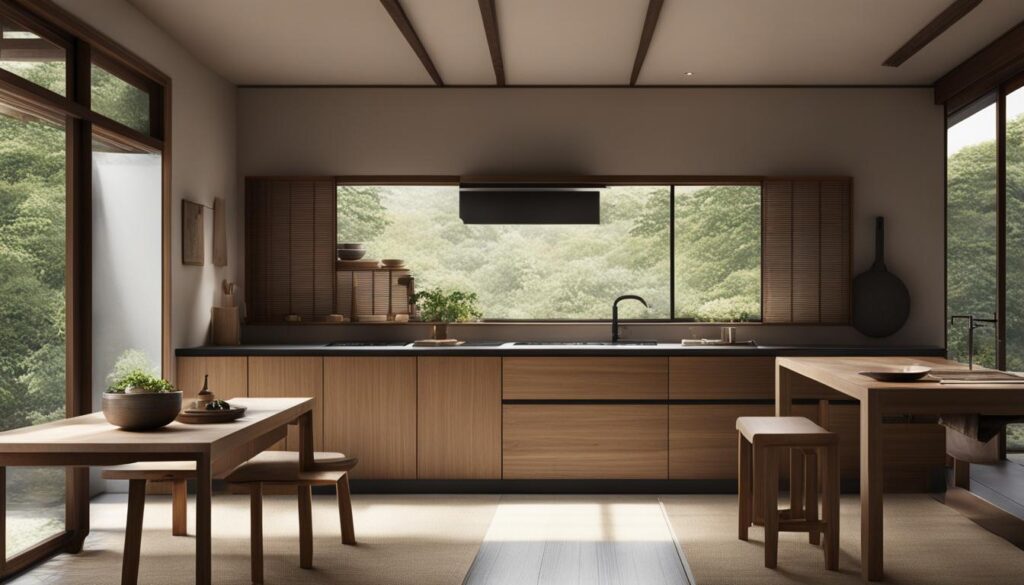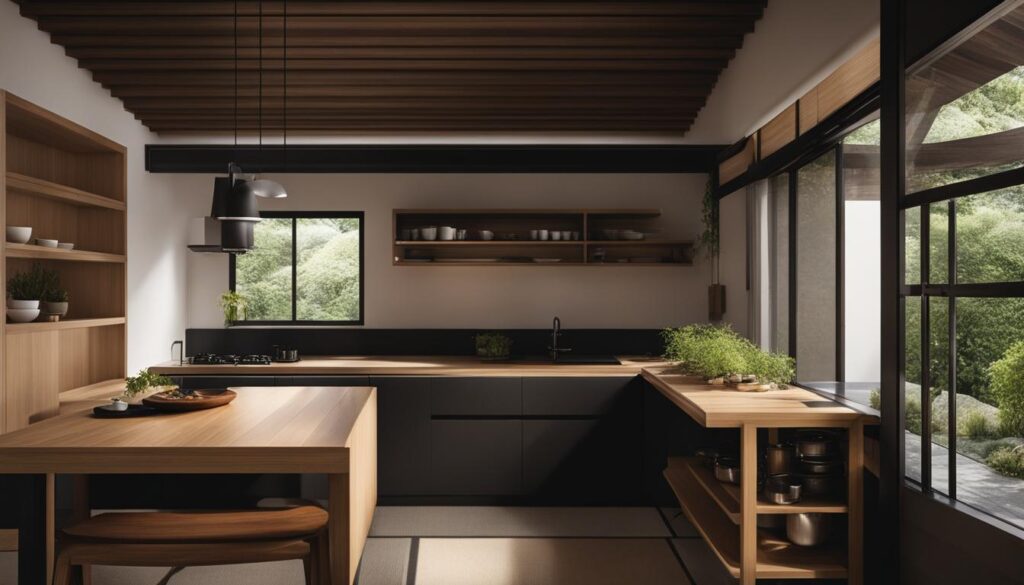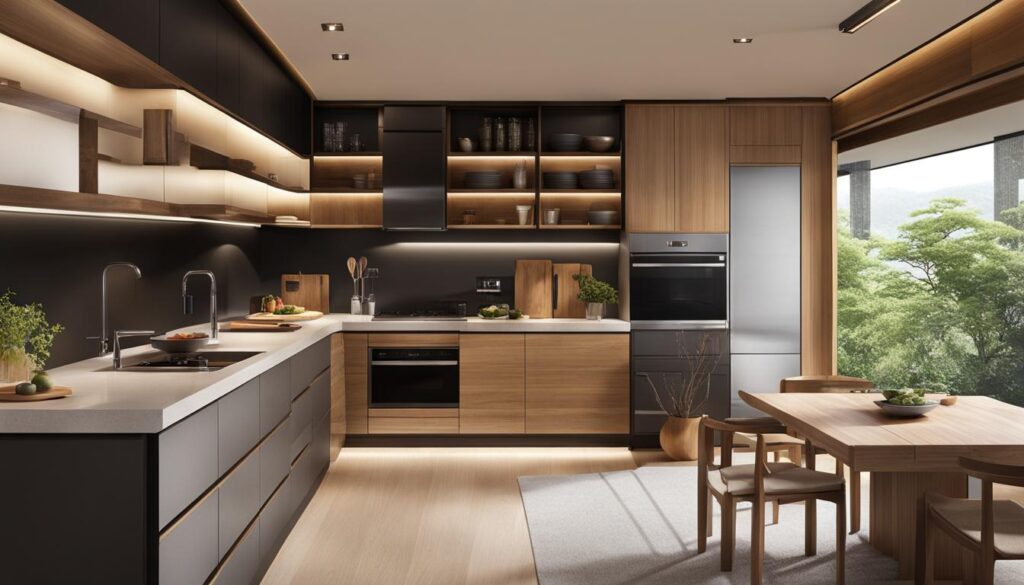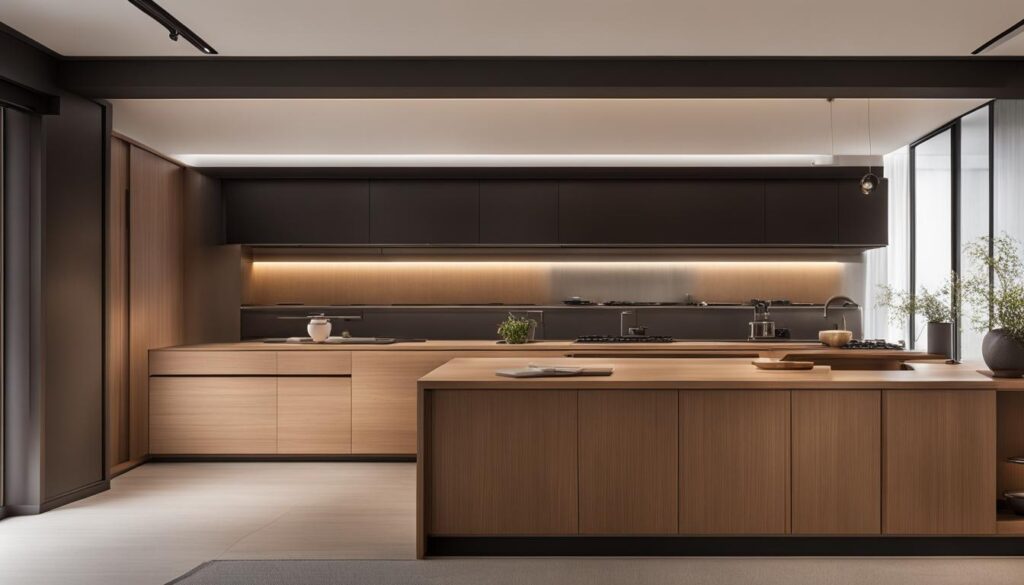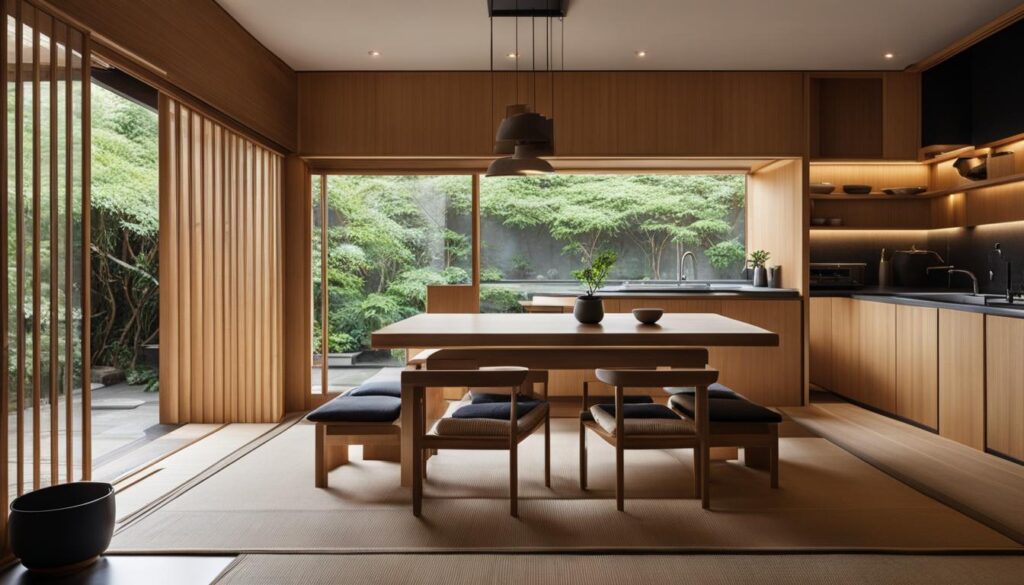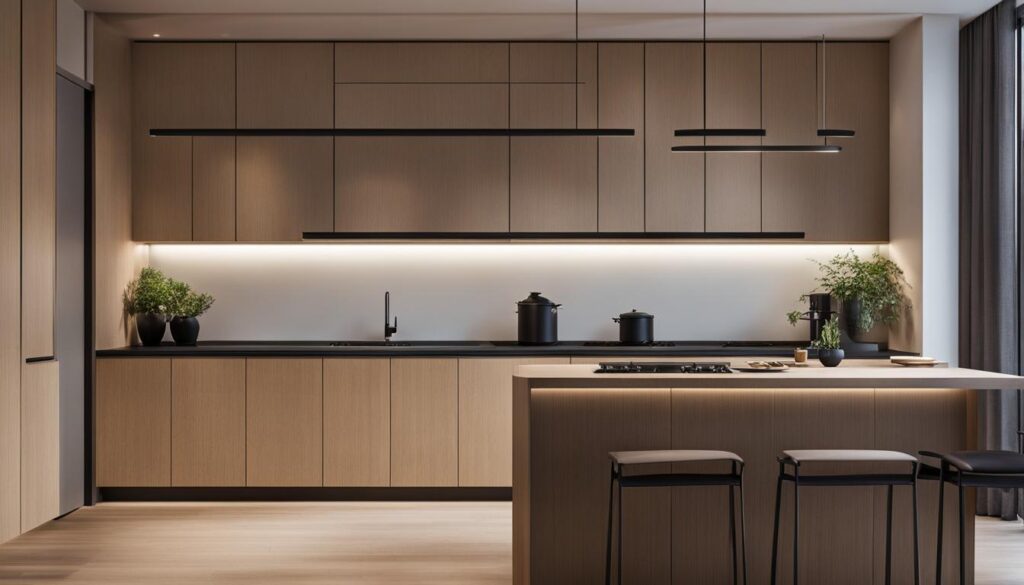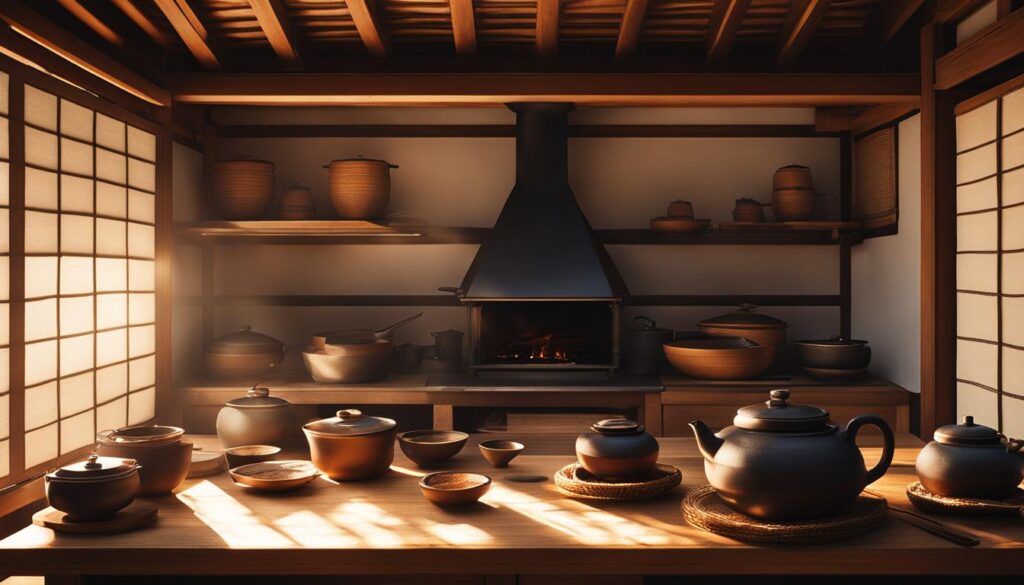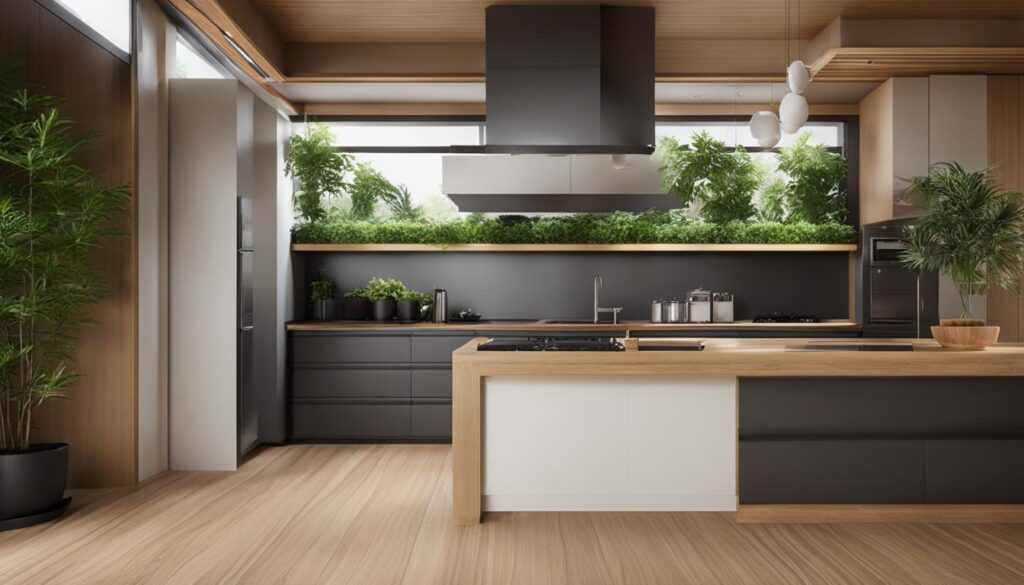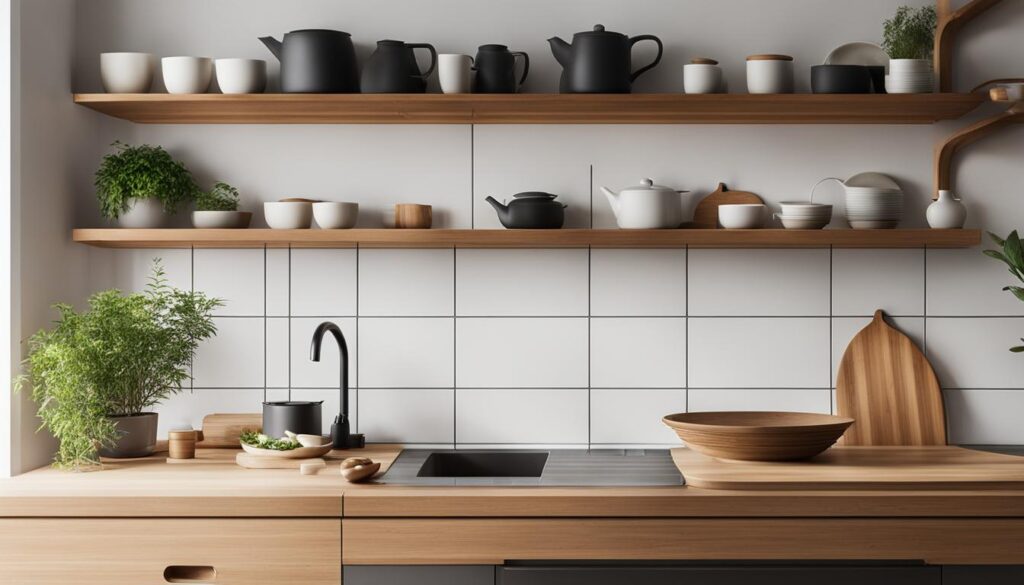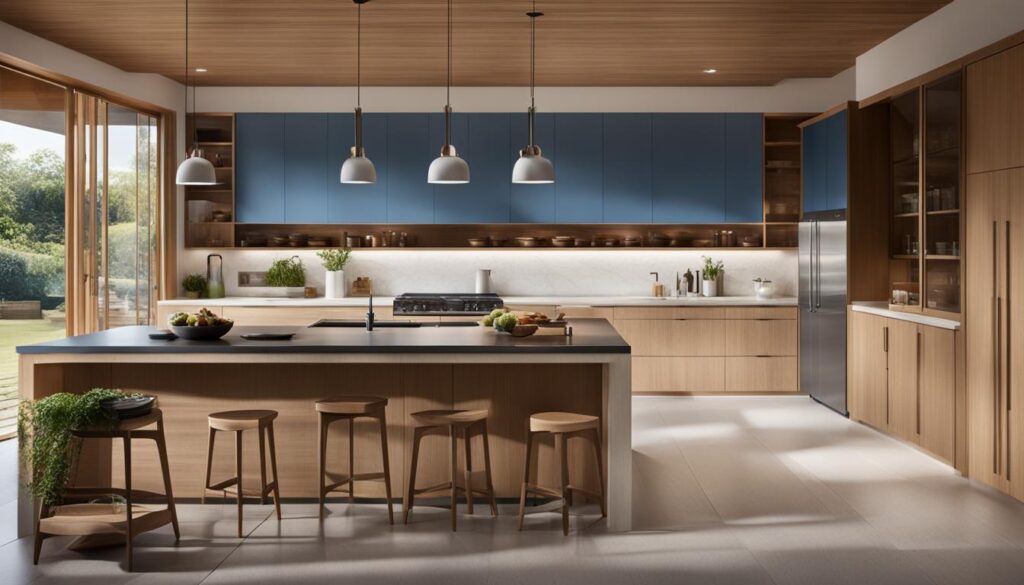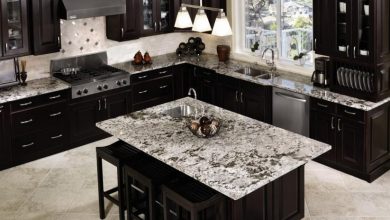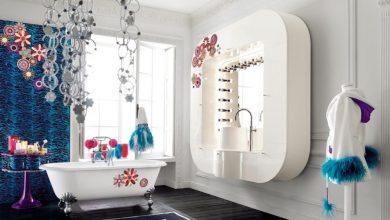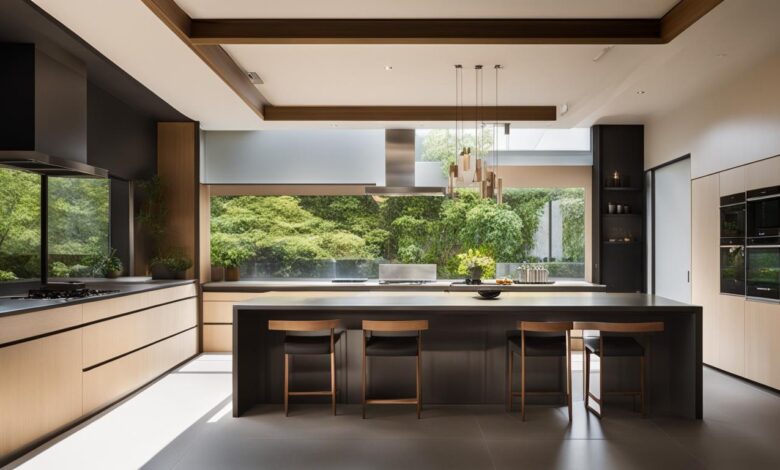
Are you looking to transform your kitchen space into a haven of serenity and style? Look no further than Japanese kitchen design. Drawing inspiration from the elegance and functionality of Japan, Japanese kitchens are known for their unique style and functionality. From clean lines to decluttered spaces, Japanese kitchen design emphasizes simplicity and minimalism while incorporating natural elements to create a calming atmosphere.
Whether you’re a fan of traditional Japanese design or prefer a more modern aesthetic, there are endless Japanese kitchen design ideas to explore. From the layout and materials to the colors and lighting, every aspect of your kitchen can reflect the beauty and functionality of Japanese design.
In this section, I will introduce you to exceptional Japanese kitchen design ideas that will transform your cooking space. We will explore the unique style and functionality of Japanese kitchens, drawing inspiration from the elegance and serenity of Japan. Let’s dive in!
Key Takeaways:
- Japanese kitchen design emphasizes simplicity, minimalism, and natural elements.
- There are endless Japanese kitchen design ideas to explore, from traditional to modern.
- Japanese kitchens incorporate clean lines, decluttered spaces, and calming atmospheres.
- The layout, materials, colors, and lighting in Japanese kitchens reflect the beauty and functionality of Japanese design.
- Transforming your kitchen with Japanese design can enhance your cooking experience and reflect your personal taste.
Embracing Japanese Minimalism in Kitchen Design
As a lover of both Japanese-inspired kitchens and minimalist design, I have found that incorporating traditional Japanese elements into my kitchen design has resulted in a serene and functional space. Japanese-inspired kitchens are known for their clean lines, uncluttered spaces, and natural materials, all of which align perfectly with the principles of minimalism.
When considering a Japanese-inspired kitchen design, start with the basics: clean lines, neutral colors, and natural textures. Opt for simple, functional cabinets in light or natural wood tones, paired with stainless steel appliances for a sleek and modern feel. You can also integrate traditional Japanese elements, like shoji screens or tatami mats, to add warmth and character to the space.
Another essential aspect of Japanese kitchen design is creating a sense of openness and flow. Consider an open-concept layout that seamlessly integrates the kitchen into the surrounding living spaces, with sliding doors or partitions that can be closed when desired. This creates a harmonious and cohesive environment that enhances the overall functionality of the space.
Lighting is also crucial in Japanese kitchen design, as it can create a calming and serene atmosphere. Choose fixtures that provide ample task lighting while also highlighting the natural textures and materials in the space. Consider adding natural light sources like skylights or large windows to enhance the overall ambiance.
Embracing Japanese Minimalism in Kitchen Design
“Japanese-inspired kitchens are all about minimalism and simplicity. By incorporating traditional Japanese elements, like natural materials and clean lines, you can create a functional and serene space.”
Elements of Japanese Kitchen Style
Japanese kitchen style is defined by its simplicity, elegance, and functionality. The layout, materials, and design elements all contribute to a calming and harmonious atmosphere. Let’s take a closer look at the key elements of Japanese kitchen style.
The Japanese Kitchen Layout
The layout of a Japanese kitchen is designed to promote efficiency and easy access to all necessary items. The “kitchen triangle” concept is often used, which places the sink, stove, and refrigerator in a triangle pattern for optimal movement while cooking. This layout also emphasizes the importance of storage and organization, with cabinets and drawers strategically placed for easy access.
Japanese Interior Design in the Kitchen
Japanese interior design in the kitchen emphasizes natural materials such as wood, bamboo, and stone. These materials are often left untreated, showcasing their natural beauty. Minimalism is also a key aspect of Japanese design, with a focus on decluttered spaces and clean lines. A neutral color palette with small pops of color adds to the serene atmosphere.
Minimalist Japanese Kitchen Design
Minimalist Japanese kitchen design is all about simplicity and functionality. Unnecessary items are omitted, and the focus is on creating a space that promotes ease of use and tranquility. Storage solutions are cleverly integrated into the design to maintain a clean, uncluttered space.
“The Japanese style of cooking is about simplicity and taste. And the kitchen should reflect that same philosophy.”
Kitchen Design with Japanese Style Elements
When designing a kitchen with Japanese style elements, it’s important to pay attention to the details. Simple and elegant design elements such as Shoji screens, sliding doors, and tatami mats can be integrated to create an authentic Japanese ambiance. These traditional Japanese elements can be paired with modern appliances for a balance of tradition and contemporary functionality.
Incorporating Japanese Design in Kitchen Accessories
Small details such as tableware, utensils, and other kitchen accessories also play a crucial role in Japanese kitchen design. Simple and functional designs are favored, with a focus on natural materials such as wood and ceramics. These accessories not only add to the overall aesthetic but also enhance the functionality of the kitchen.
Incorporating Japanese elements into your kitchen design can create a calming and functional space. The layout, materials, and design elements all work together to promote efficiency, simplicity, and elegance. By paying attention to the details and focusing on function and simplicity, a Japanese-style kitchen can be a beautiful and inspirational space.
Blending Tradition and Modernity in Japanese Kitchen Designs
Japanese kitchen design is all about finding a balance between traditional and modern elements. The result is a harmonious space that reflects the elegance and functionality of Japanese design while catering to the needs of contemporary living.
When designing a Japanese style kitchen, it’s important to draw inspiration from traditional design elements such as natural materials, clean lines, and muted color palettes. However, it’s equally important to embrace modern materials, appliances, and storage solutions to create a functional kitchen that meets the demands of modern life.
Embracing Traditional Japanese Design Elements
Traditional Japanese kitchens typically feature natural materials such as wood, bamboo, and stone. These materials are used to create a warm and inviting atmosphere that captures the essence of nature. In a modern Japanese kitchen, you can incorporate these elements in a variety of ways:
- Install wooden cabinetry or shelving
- Use natural stone or bamboo flooring
- Add a wooden or bamboo kitchen island
These traditional elements can be paired with modern appliances and fixtures to create a kitchen that is both functional and beautiful.
Embracing Modernity in Japanese Kitchen Design
Embracing modernity in a Japanese kitchen can be as simple as incorporating sleek, modern cabinetry, or as complex as installing the latest high-tech appliances. When selecting modern design elements, it’s important to keep in mind the overall aesthetic of the kitchen and choose elements that complement the traditional elements.
Modern Japanese kitchens often feature:
- Sleek, minimalist cabinetry
- Stainless steel or chrome fixtures
- High-tech appliances
Pairing these modern elements with traditional design elements creates a kitchen that is both functional and elegant, embracing the best of both worlds.
Bringing Tradition and Modernity Together
The key to successfully blending tradition and modernity in a Japanese kitchen design is to find a balance between the two. When selecting materials, fixtures, and appliances, consider how they complement each other. For example, you can pair sleek, modern appliances with traditional wooden cabinetry or shelving. This creates a harmonious balance between the modern and traditional elements, creating a functional and beautiful kitchen space.
When designing a Japanese style kitchen, don’t be afraid to experiment with different materials, colors, and design elements. The result will be a unique, personalized kitchen that reflects your personal style and enhances your culinary experience.
The Beauty of Japanese Kitchen Cabinets
When it comes to Japanese kitchen design, the cabinets play an essential role in both aesthetics and functionality. Japanese kitchen cabinets are crafted with precision and attention to detail, featuring unique features that set them apart.
The cabinet doors are typically made of natural materials such as wood, and they have a simple and clean design that blends seamlessly with the overall Japanese kitchen style. The wood grain and texture are also left exposed, adding warmth and character to the kitchen.
One popular type of Japanese kitchen cabinet is the “tansu” cabinet. These cabinets are traditional Japanese storage pieces that were originally used for clothing. Today, they have been adapted for use in modern kitchens, offering a unique blend of tradition and functionality.
| Cabinet Type | Description |
|---|---|
| Tansu Cabinet | Traditional Japanese storage piece |
| Hakone Yosegi | Wooden mosaic pattern on cabinet doors |
| Shoji Cabinet | Cabinets with Japanese paper sliding doors |
The Hakone Yosegi is another type of Japanese kitchen cabinet that features a wooden mosaic pattern on the cabinet doors. This unique design adds visual interest to the kitchen and showcases the artistry and craftsmanship of Japanese woodworking.
Shoji cabinets are another option for those who want to incorporate traditional Japanese design into their kitchen. These cabinets feature Japanese paper sliding doors that allow light to pass through, creating a sense of openness and airiness in the kitchen.
Overall, Japanese kitchen cabinets offer a unique blend of beauty and functionality that is hard to find elsewhere. Whether you opt for traditional tansu cabinets or modern-day adaptations, Japanese kitchen cabinets are sure to enhance the aesthetics of your kitchen and enrich your cooking experience.
Infusing Traditional Japanese Design in Kitchen Interiors
As I explore Japanese kitchen design, I find that traditional Japanese design principles are crucial to creating a harmonious and inviting space. A traditional Japanese home kitchen is often a place where family members gather to cook and eat, so it’s essential to ensure that it’s functional, organized, and aesthetically pleasing. Here are some ideas for infusing traditional Japanese elements into your kitchen interiors.
Japanese Home Kitchen
In a traditional Japanese home, the kitchen is usually a separate room that’s closed off from the living spaces. The room’s design is simple, functional, and emphasizes natural materials. Using shoji screens instead of walls is a popular way to separate the kitchen from the rest of the home while maintaining an open and airy feel.
The kitchen should be designed to accommodate the specific needs of the household members. For example, if someone is left-handed, the placement of the stove may need to be adjusted for their comfort. In a traditional Japanese home, the kitchen is also often a shared space where family members take turns cooking and cleaning up.
Japanese Kitchens Design Ideas
When designing your Japanese-style kitchen, consider using natural materials such as wood, bamboo, and stone. These materials bring warmth and texture to the space and create a connection to nature, which is an essential element of Japanese design.
Another idea to consider is incorporating a tokonoma, a small alcove that’s used to display artwork, flower arrangements, or other decorative items. This element is often found in traditional Japanese homes and creates a focal point in the kitchen.
Modern Japanese Kitchen Designs
If you’re interested in a more modern interpretation of Japanese kitchen design, consider incorporating sleek lines, minimalist elements, and pops of color. A simple color palette can help create a serene and calming atmosphere in the space.
Using Japanese cookware and tableware can also add a traditional touch to a modern kitchen. For example, a cast iron teapot or a bamboo steamer can be both functional and decorative.
Infusing traditional Japanese design elements into your kitchen interiors is a great way to create a welcoming and peaceful space. Whether you opt for a more traditional or modern approach, using natural materials, simple lines, and functional elements can help you achieve your desired style.
Creating a Cozy and Functional Small Japanese Kitchen
If you’re like me, living in a small apartment or house with a tiny kitchen can be challenging. However, with the right design and mindset, you can create a cozy and functional small Japanese kitchen that meets your culinary needs.
When designing a small Japanese kitchen, minimalism should be your guiding principle. Simplify your space by eliminating unnecessary clutter and excess furniture to create a serene and spacious ambiance. Embrace the clean and uncluttered lines of Japanese design to create a visually stunning kitchen with maximum functionality.
One of the ways to achieve a minimalist Japanese kitchen design is by opting for built-in storage units. Choose cabinets with ample storage space that can blend seamlessly with your kitchen’s interior. You can also explore the idea of suspended shelving to increase storage while adding texture and visual interest to your kitchen.
Another essential aspect of a small Japanese kitchen design is the use of natural light. Incorporate large windows into your kitchen’s design to allow natural light to flood your space. This creates an illusion of more space while providing a calming and peaceful environment. You can also consider adding ambient lighting fixtures that work together to create a warm and inviting atmosphere.
Finally, focus on functionality by choosing compact appliances that fit seamlessly into your small Japanese kitchen design. Swap your regular-sized fridge for a mini-fridge to save space or opt for a slimline dishwasher that fits under your countertop. These small changes will significantly enhance the functionality of your kitchen while allowing you to maximize your limited space.
In conclusion, creating a cozy and functional small Japanese kitchen requires a thoughtful and minimalist approach. By embracing natural light, built-in storage, and compact appliances, you can transform your tiny kitchen into a serene and functional space that meets your culinary needs.
Rustic Charm in Japanese Kitchen Design
As a lover of nature and traditional country homes, I’ve always been drawn to the rustic charm of Japanese kitchen design. The warm colors, natural materials, and minimalist aesthetics create a cozy and inviting atmosphere that makes cooking an enjoyable experience. If you’re looking to infuse your kitchen with a touch of rustic Japanese charm, here are some ideas to inspire you.
Let’s start with the color palette. Rustic Japanese kitchens tend to feature warm, earthy tones such as brown, beige, and olive green. These colors create a harmonious and calming environment that reflects the natural beauty of the surrounding landscapes. Consider painting your walls in a soft beige or adding earthy accents such as a terracotta backsplash or wooden countertops.
Speaking of wood, it’s a crucial element in rustic Japanese kitchens. From the floors to the cabinets, wood adds warmth, texture, and character to the space. Opt for natural wood finishes like cedar or bamboo to create an authentic Japanese ambiance. You can also incorporate wood through kitchen accessories such as cutting boards, utensils, and bowls.
Another feature of rustic Japanese kitchens is the use of traditional elements. A shoji screen, for example, can serve as a divider between the kitchen and dining area while creating a sense of privacy and serenity. A beautiful Japanese-style garden outside the kitchen window can also enhance the rustic charm of the space.
To tie it all together, consider showcasing your kitchen items in open shelves or glass cabinets. A collection of traditional Japanese pottery or cookware can add a touch of authenticity and personality to your kitchen.
Japanese-Inspired Kitchen Ideas:
| Element | Description |
|---|---|
| Natural Materials | Incorporate natural wood and stone finishes to create a warm and rustic atmosphere. |
| Warm Color Palette | Stick to earthy tones such as beige, brown, and olive green to create a calming environment. |
| Traditional Elements | Incorporate Japanese-inspired elements such as shoji screens, tatami mats, and bonsai trees. |
| Open Shelves | Showcase your collection of traditional Japanese pottery or cookware in open shelves or glass cabinets. |
With these Japanese-inspired kitchen ideas, you can create a cozy and inviting cooking space that reflects your personal style and love for nature. Embrace the warmth and simplicity of rustic Japanese design and make your kitchen a haven of inspiration.
Embracing Nature in Japanese Kitchen Design
As I continue to explore Japanese kitchen design ideas, I am fascinated by the way nature plays a central role in creating a calm and harmonious space. Japanese design principles often emphasize the importance of bringing the outdoors inside, creating a connection to nature that enhances our well-being.
When it comes to Japanese kitchen design, incorporating natural materials and elements is key to achieving an authentic and peaceful ambiance. Here are some ideas to infuse your kitchen with the beauty of nature:
- Introduce greenery: Adding indoor plants or a small herb garden in your kitchen can add freshness and color to your space, while also purifying the air.
- Use earthy materials: Consider using natural materials such as wood, bamboo, or stone to create a warm and inviting atmosphere.
- Maximize natural light: If possible, allow natural light to flood your kitchen by installing large windows or skylights. This will not only create a bright and airy space but also connect you to the outdoor world.
Another important aspect of Japanese kitchen design is the layout. Japanese kitchens are often designed with the concept of “kitchen triangle,” where the stove, sink, and refrigerator are arranged in a triangle shape to minimize movement and enhance efficiency.
To achieve an authentic design, consider consulting a professional to help you with the layout and ensure a functional kitchen that maximizes space and functionality. Japanese-style cabinets can also enhance the aesthetics of your kitchen, featuring clean lines and minimalistic design, while providing ample storage space.
Table: Popular Japanese Kitchen Layouts
| Layout Type | Description |
|---|---|
| I-Shaped Kitchen | A simple and space-saving layout with a straight-line design, ideal for a small kitchen. |
| L-Shaped Kitchen | A layout that features a perpendicular counter, providing ample workspace and storage space on both walls. |
| U-Shaped Kitchen | A layout that features three walls of cabinetry and counter space, providing ample space for cooking and storage. |
By embracing nature in your Japanese kitchen design, you can create a space that’s not only beautiful but also calming and functional. And with careful planning and attention to detail, you can achieve an authentic design that reflects your personal style and enhances your culinary experience.
Enhancing Your Japanese Kitchen with Functional Accessories
Bringing functionality and style together is key to creating an exquisite Japanese kitchen. In this section, I will explore some unique functional accessories that can enhance the efficiency and aesthetics of your kitchen.
Japanese Style Kitchens
Traditional Japanese kitchens are designed with functionality, simplicity, and elegance in mind. To enhance the functionality of your Japanese kitchen, you will need some essential accessories such as:
- A rice cooker to prepare moist, delicious rice that is a staple of Japanese cuisine.
- A Tamagoyaki pan to cook delicious rolled omelets that are perfect for breakfast or lunchboxes.
- A Japanese-style teapot to brew delicious tea that pairs well with Japanese dishes.
These functional accessories not only enhance the efficiency of your kitchen but also add a touch of Japanese elegance.
Japanese Kitchen Cabinets
Japanese kitchen cabinets are known for their exceptional craftsmanship and unique features. To enhance the aesthetics of your Japanese kitchen, opt for cabinets made from natural materials such as wood, bamboo, or rattan. These materials add a warm and natural look to your kitchen, creating a serene and cozy ambiance.
Another functional accessory you can add to your Japanese kitchen cabinet is a pullout rack. This rack can help organize your kitchenware, making them easily accessible and freeing up counter space. Make sure to choose one that matches the design and color of your cabinets for a harmonious look.
Japanese Kitchen Decor
The right decor can transform your Japanese kitchen into a haven of serenity and style. Here are some functional accessories that can enhance the aesthetics of your kitchen:
- A Japanese-style apron to protect your clothes and add a touch of elegance to your cooking experience.
- A small indoor plant to add a touch of nature to your kitchen and create a calming atmosphere.
- A set of traditional Japanese chopsticks and chopstick rests to elevate your dining experience.
These functional accessories not only enhance the aesthetics of your Japanese kitchen but also add functionality to your cooking space.
With these functional accessories, you can take your Japanese kitchen design to the next level. By adding functionality and style to your cooking space, you can create a serene and inviting ambiance that enhances your culinary experience.
Lighting and Colors in Japanese Kitchen Design
When designing a Japanese kitchen, lighting and colors are essential elements that can create a serene and inviting atmosphere. Japanese kitchen interior design often features subdued lighting, which helps to create a calm, relaxing environment. Soft lighting can be achieved with the use of pendant lights, under-cabinet lighting, and even candles to bring a warm glow to the space.
Color is also a key factor in Japanese minimalist kitchen design. Neutral tones such as beige, white, and gray are often used to create a clean and uncluttered look. These colors can be complemented by natural wood tones or even pops of green from indoor plants for a touch of nature indoors.
The Role of Lighting in Japanese Kitchen Design
Lighting plays a crucial role in Japanese kitchen design, as it sets the mood and creates the ambiance of the space. Soft, dim lighting helps to create a relaxing atmosphere, while bright lights are ideal for cooking and food preparation. Pendant lighting is a popular choice for Japanese kitchens, as it provides ample lighting without being too harsh on the eyes.
Under-cabinet lighting is another option, as it provides subtle illumination for tasks such as chopping vegetables or washing dishes. Additionally, candles can be used to create a warm, intimate atmosphere in the kitchen.
Choosing Colors for Japanese Minimalist Kitchen Design
Neutral colors are a staple of Japanese minimalist kitchen design, as they create a clean, uncluttered look. White, beige, and gray are popular choices, as they pair well with natural wood tones and add a sense of tranquility to the space.
When selecting colors for your Japanese kitchen, it’s essential to consider the role of natural light in the space. If your kitchen receives a lot of natural light, you can incorporate brighter colors such as yellow or green for a touch of warmth and energy. However, if your kitchen is naturally darker, it’s best to stick with neutral tones to create a soothing atmosphere.
Embrace the Elegance of Japanese Design
From incorporating natural materials to maximizing storage in small spaces, there are countless ways to infuse your kitchen with the elegance and functionality of Japanese design. By embracing the principles of minimalism and simplicity, you can create a calming and harmonious environment that promotes relaxation and creativity in the kitchen.
Find Your Personal Style
Remember, the key to creating a truly exceptional Japanese kitchen is to find a style that reflects your individual taste and needs. Whether you prefer traditional or modern design elements, there are endless ways to infuse your kitchen with Japanese-inspired touches that enhance both function and style.
Bring Your Vision to Life
By combining functionality with style, you can create a Japanese kitchen that truly reflects your personal vision and enhances your culinary experience. With careful attention to detail and an eye for beauty, you can transform your cooking space into a haven of serenity and style that inspires you to create delicious meals and unforgettable memories for years to come.
Conclusion
Inspired by the beauty and functionality of Japanese kitchen design, I hope these ideas have sparked your creativity and motivated you to transform your own cooking space. Whether you’re drawn to the simplicity of minimalist design or the warmth of rustic charm, Japanese kitchen style offers endless possibilities for creating a serene and inviting environment that enhances your culinary experience.
FAQ
What are some key elements of Japanese kitchen design?
Japanese kitchen design emphasizes clean lines, minimalism, and functionality. Natural materials, such as wood and bamboo, are often used, and the layout is carefully planned to maximize efficiency and create a harmonious space.
How can I incorporate Japanese minimalism into my kitchen design?
To embrace Japanese minimalism, focus on decluttering your kitchen and creating clean, uncluttered surfaces. Opt for simple, streamlined cabinets and storage solutions, and use neutral colors to create a calm and serene atmosphere.
What are some ideas for creating a cozy and functional small Japanese kitchen?
In a small Japanese kitchen, maximize functionality by utilizing space-saving storage solutions and clever organization techniques. Choose multi-purpose furniture and prioritize essential kitchen tools. Additionally, consider using light colors and strategic lighting to create an illusion of space.
How can I strike a balance between traditional and modern elements in my Japanese kitchen design?
Blend traditional and modern elements in your Japanese kitchen design by incorporating traditional materials, such as wood, alongside sleek modern appliances. Combine traditional design motifs with contemporary functionality to create a harmonious and unique kitchen space.
What are some functional accessories that can enhance a Japanese kitchen?
Traditional Japanese utensils, such as bamboo steamers and ceramic teapots, can enhance the functionality of your kitchen while adding a touch of authenticity. Additionally, consider incorporating clever storage solutions, like pull-out pantry shelves or hanging pot racks.
How can lighting and colors contribute to a Japanese kitchen design?
Lighting and colors play a crucial role in creating a serene and inviting atmosphere in a Japanese kitchen. Use warm, natural lighting fixtures to create a soft ambiance, and choose a color palette inspired by nature, such as earthy tones and soft greens.
How can I infuse traditional Japanese design into my kitchen interiors?
To infuse traditional Japanese design into your kitchen, consider incorporating elements such as sliding doors (shoji), tatami mats, or traditional Japanese artwork. Use natural materials like wood and paper, and create a Zen-like atmosphere through carefully chosen decorative elements.
What are some ideas for bringing nature into a Japanese kitchen design?
To bring nature into your Japanese kitchen design, consider incorporating indoor plants for a touch of greenery. Use natural materials like stone or wood for countertops or flooring. Additionally, think about incorporating large windows or a view of a serene outdoor space.
How can I create a rustic Japanese kitchen design?
To create a rustic Japanese kitchen, embrace natural materials like rough-hewn wood and earthy colors. Opt for traditional Japanese elements like sliding doors or exposed wooden beams. Consider adding a touch of warmth with rustic pottery and woven textiles.
How can Japanese kitchen cabinets enhance my kitchen’s aesthetics?
Japanese kitchen cabinets are known for their exquisite craftsmanship and unique features. From traditional styles with intricate detailing to modern minimalistic designs, Japanese cabinets can elevate the aesthetics of your kitchen and add a touch of elegance.
What is the overall goal of Japanese kitchen design?
The goal of Japanese kitchen design is to create a harmonious and functional space that balances aesthetics, efficiency, and tranquility. By incorporating elements of nature, minimalism, and traditional Japanese design, you can create a kitchen that inspires creativity and enhances your culinary experience.

